Note: This website was automatically translated, so some terms or nuances may not be completely accurate.
We Asked! The Real Smartphone Lives of Young People in the Smartphone Generation [Part 1]
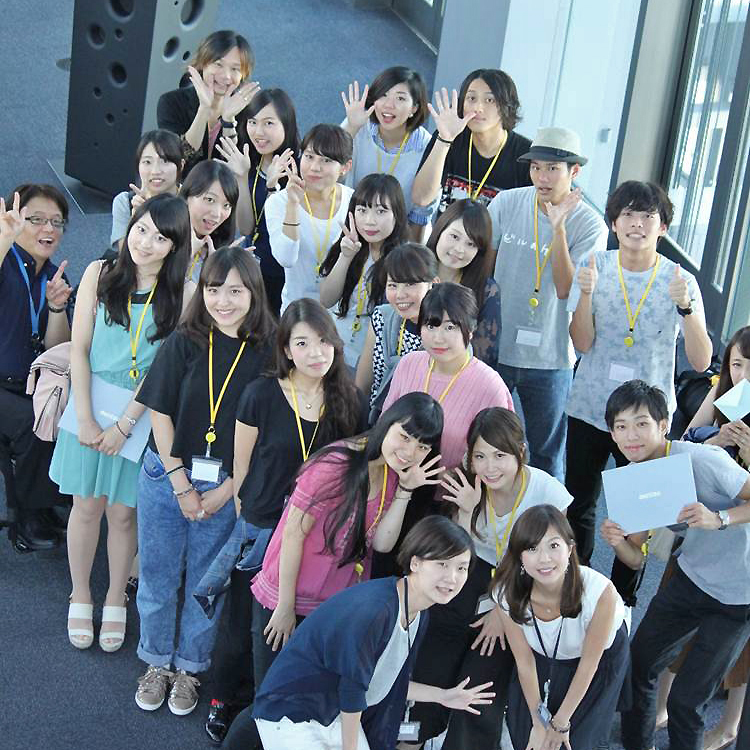
Hello, I'm Seto from Dentsu Inc. Smart Plus. Last time, we analyzed how smartphone proliferation has shifted perspectives on consumption. This time, we'll explore how smartphones actually influence consumption among the smartphone generation, based on real user voices.
We present the details of a joint workshop conducted by the Suzuki Seminar at Kwansei Gakuin University's Faculty of Sociology and Dentsu Smart Platform, with the cooperation of the seminar members, over two installments.
In the workshop, 19 participants in their early 20s – genuine members of the smartphone generation – reflected on their own shopping habits. Through peer interviews, they uncovered the actual processes and realities of their consumption behaviors.
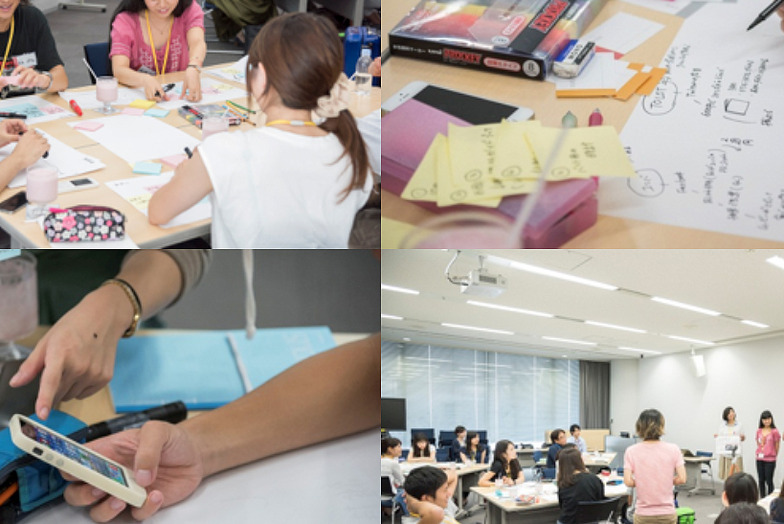
What emerged was a completely different way of using smartphones as a new tool, distinct from the consumer behavior captured by traditional advertising and marketing. So, what kind of consumption behavior are young people of the smartphone generation actually engaging in?
Smartphones play a vital role in purchasing and considering all kinds of products
The members of the Suzuki Seminar, who regularly study sociology and marketing and deeply reflect on their own actions and awareness, provided fascinating insights into consumption patterns that wouldn't surface from simply asking peers of the same age. They also delved deeply into their own feelings. Discussions were lively about various shopping situations, ranging from high-priced items like homes and travel to relatively casual purchases like diet protein bars and facial cleansing nets. Here, we highlight some particularly memorable cases. I've also briefly summarized the discoveries and insights gained from everyone's shopping habits after each case.
"Enjoying the Virtual Experience Before Considering the Real One" [Live Concerts] Ms. M (21)
Music lover M wanted to discover great music, so she searched for new bands on YouTube. Finding a band she liked, she checked their Twitter account, enjoyed their music videos and live footage, and simultaneously looked up real-life concert info. While researching venues, she grew eager to attend. She casually posted on social media hoping to find someone to go with, and surprisingly, a long-lost university senior responded. They connected directly via LINE and ended up going to the concert together.
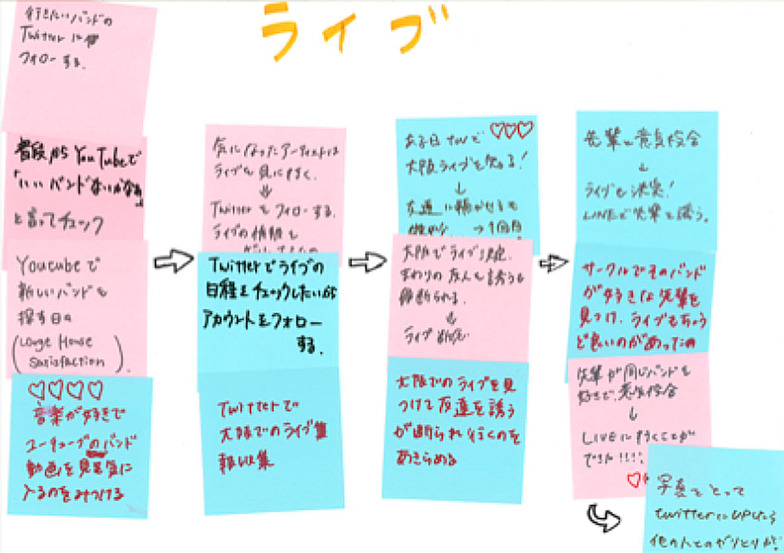
It's true that nowadays, there are more experiences available without spending money. You can often listen to full songs for free, and there are plenty of immersive live videos and music videos to enjoy. Creating that emotional journey on smartphones—where you enjoy the virtual experience and then genuinely want to pay for the real-life experience—will be a key point moving forward.
On the other hand, taking this case as an example, it's also important to recognize that the value lies in the live experience, not the CD. We should pause and reconsider what the real value—the thing we should be selling—is that lies beyond the virtual experience.
"Mark what you want immediately!?" [Outdoor Brand Backpack] Mr. H (20)
Mr. H, a male student, stumbled upon a backpack while casually browsing an outdoor brand store. He already owned a black one, but this time, the pockets, size, and material appealed to him, making him want it.
So, on his way home, he saved an image of the product on his phone. Later, he looked at that image several times, thinking it over carefully. He reflects that by revisiting the image, he was "letting his desire mature" within himself. However, he also admits that this act, somewhat like a dog "marking its territory," gave him a sense of "ownership" and satisfaction, which is why he still hasn't pulled the trigger on the purchase. He analyzed his situation: "Even though I've wanted it for a long time and still want it now, things like movies or ramen have higher priority."
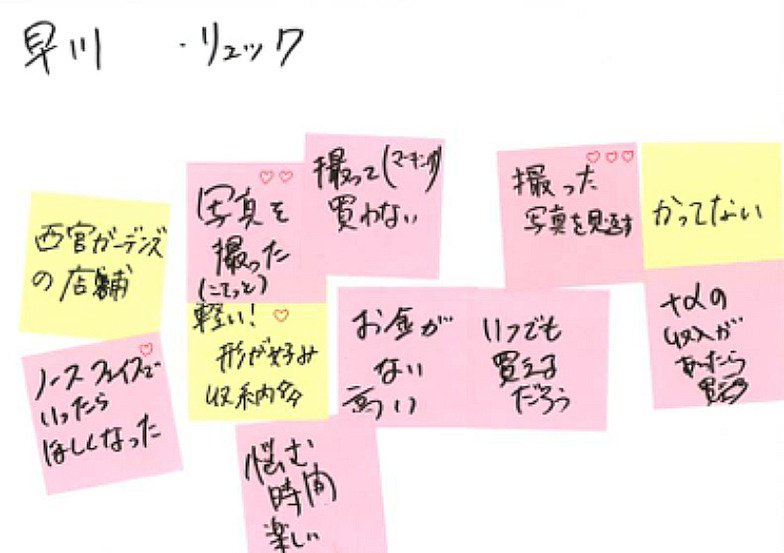
The challenge and opportunity here seem to lie in pushing Mr. H to actually make the purchase, rather than just being satisfied with marking his territory. For example, promotional strategies could involve sending one-to-one messages via SNS to users who mark, or even providing more tangible, real-world experiences.
"I want to be convinced, so I use my phone to thoroughly fuel my 'I want it!'" [Luggage] Ms. S (21)
Ms. S saw Fumi Nikaido on the TV show "Another Sky" and wanted a suitcase from the same brand. However, she gave up after seeing the high price on the brand's website. She then searched "college girl recommended suitcases." An article on "MERY" caught her eye, featuring a suitcase showcased in the drama "Heartbroken Chocolatier." She tracked down the brand. Concerned about the price, she searched for cheaper options and planned to check them in-store. But they were out of stock that day, so she gave up. She eventually bought it during a ZOZOTOWN sale. Now, S-san can talk about the suitcase's appeal like a salesperson.
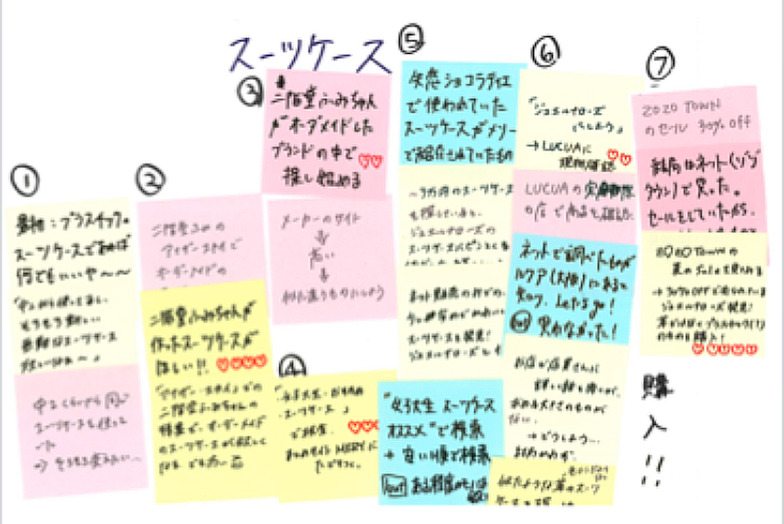
It's true, isn't it? Sometimes you start researching things like "because that person uses it" or "the design seems popular," or maybe price and features, and as you dig deeper, information piles up, and you become incredibly knowledgeable. S-san, too, discovered the multifaceted appeal of the product through her smartphone, and her desire to "have that suitcase" just kept growing.
"Wanting it three times is proof you're serious" [Kindle] Ms. W (20)
W-san has a rule: "Since I get obsessed with trendy things quickly, I buy something only after three waves of wanting it." Looking back, she actually experienced three waves before purchasing her recent Kindle.
The first wave came when she saw it mentioned online or on TV news, thinking "This seems to be trending." The second wave hit when she spotted someone using one in town and thought e-books looked cool. Finally, her desire peaked when she learned Naoki Matayoshi won the Akutagawa Prize, prompting her to want to remedy her reading deficit. From there, she checked prices on comparison sites, further fueling her "I want it!" feeling. She then switched to the PC site for thorough comparison and consideration, ultimately placing her order directly from her desktop.
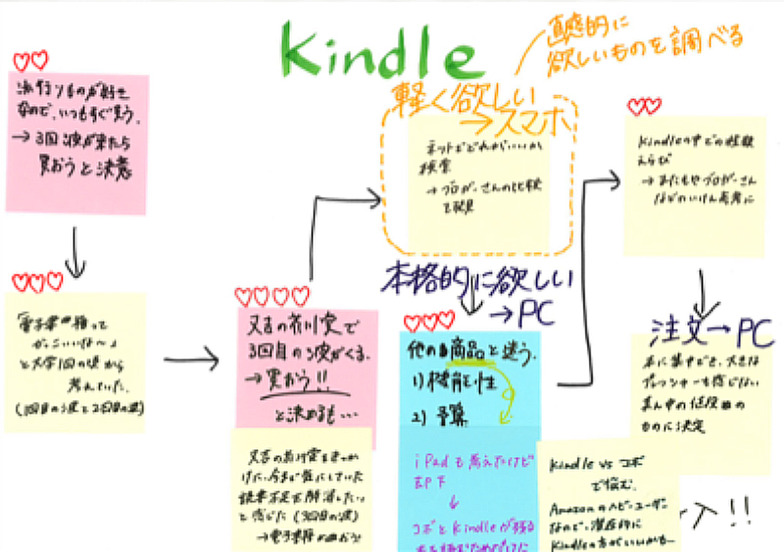
Even when rationally filtering information, repeatedly encountering the same product in different contexts seems to create a "need" feeling – a sense that "this is something I require." Communication design that leverages this insight becomes essential. Scatter contextually relevant product information across diverse media at opportune moments to build multiple peaks of desire. Regarding how to create these peaks, much like traditional contact point design, there appear to be patterns specific to each product category.
"Instagram Holds Trustworthy Examples" [Diet Protein Bars] Ms. K (21)
After deciding to diet, K first turned to Instagram. Searching "#diet" brought up numerous diet-related accounts. They shared daily meals, workout routines, and selfies taken in front of mirrors. Seeing clear progress of actual weight loss allowed her to find trustworthy, "real-life success stories." K became interested in a diet protein bar recommended by a poster she followed and researched its price on comparison sites. Though it was relatively expensive as an imported product, she found an online shop selling it cheaper and decided to buy there.

Finding a trustworthy role model and learning about real usage scenarios and progress through photos helps confirm and build the desire to have the product. Smartphones have made this process simple and commonplace. When an impartial third party openly shares detailed, real-time progress, trust and expectations regarding the product's efficacy and value surge significantly. This approach isn't limited to products emphasizing functional benefits like diet items; with smartphones now ubiquitous, it might be a universally applicable strategy across different markets.
"Actually, I'm making super solid, super rational purchases with my smartphone" [Sneakers] Ms. K (20)
K uses her smartphone to make very smart purchases. Wanting to buy at the most reasonable price possible, she seems to make her final decision after repeatedly comparing physical stores and e-commerce sites. Her recent smart purchase was sneakers, also for club activities. After researching online, she tried them on in-store to carefully check the size and fit, then perfectly timed her purchase on Amazon when the price dropped the lowest.

With a smartphone, you can check price changes in real time. Like K, many people now routinely incorporate this into their everyday shopping behavior. Even if factors like functionality or social media appeal make you think "I want this!", that final push of feeling like you got a good deal is absolutely essential. Of course, there are ways to achieve this beyond just chasing discounts, but ultimately, it's crucial to give yourself that sense of satisfaction – that you didn't lose out, that you made a smart purchase.
"I don't just blindly follow article recommendations. I see people's true feelings on Twitter." [Lotion] K (20)
Furthermore, K-san says she's currently torn between several options while trying to buy a high-end lotion. She says, "When in doubt, MERY," and this statement drew agreement from other girls.
However, these women, who process vast amounts of information daily on their smartphones, are also sensitive to how articles are written. Even when encountering information or products through curation sites like MERY, review sites, or sampling events on the street, their desire doesn't necessarily build smoothly.
In fact, the cautious Ms. K felt uneasy when checking a curation site, sensing the content was overly sales-oriented. Her response? Searching tweets on Twitter.
"No matter what, Twitter is where you find the most genuine opinions," she points out. It captures the raw, personal thoughts typed into smartphones in the moment.
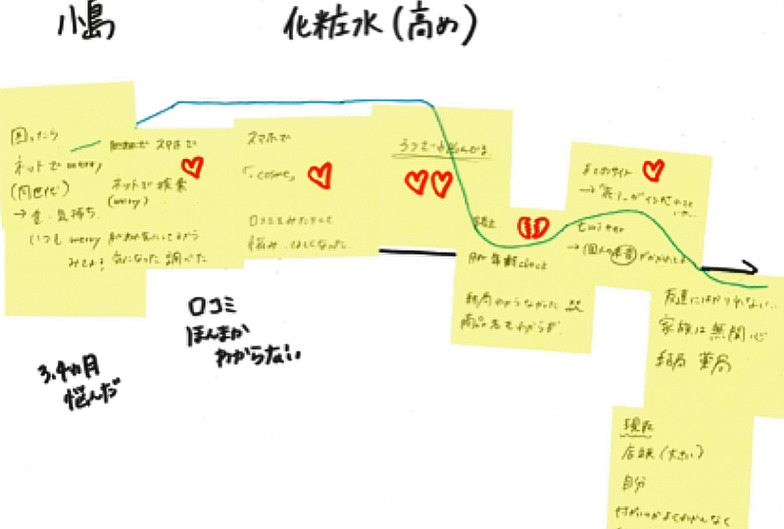
While K is certainly highly information literate, they don't seem like a rare case. It's often said that today's youth skillfully navigate multiple communities, but they're also becoming adept at choosing the optimal place not just for communicating with friends, but also for researching things like shopping.
For example, there are strategies that deliberately leverage the raw, unfiltered opinions scattered across the web for promotional purposes. Even as media and context change, we'll likely see more initiatives that take into account the awareness and behavior of these highly information-literate individuals.
"Daydreaming About a 'Slightly Future Me' Expanded by Smartphones" [New York Trip] Ms. Y (21)
Y shared how her smartphone played a role in motivating her New York trip. Initially, she hesitated because it wasn't a cheap purchase for a college student. But then, a cool photo her friend posted on SNS from NY caught her eye. "I was convinced it would look great on SNS!" she says, explaining how it made her absolutely determined to go. "My smartphone expanded my imagination," Y reflects.
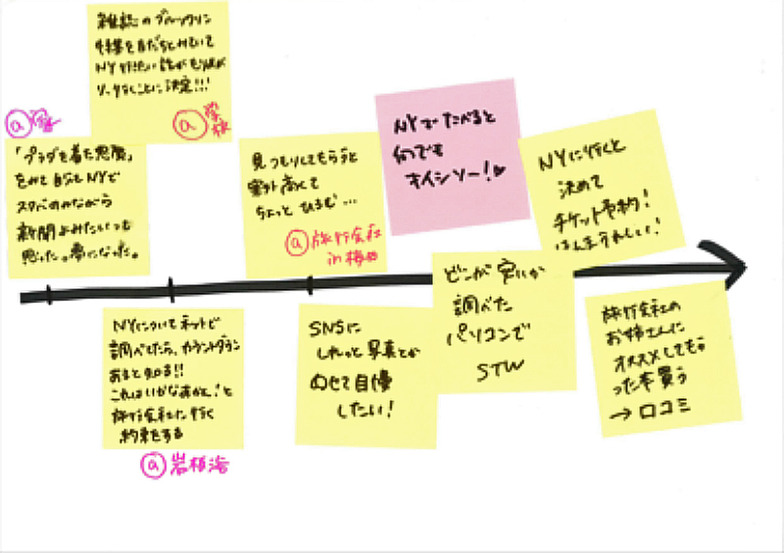
On social media, seeing friends and acquaintances using a product or service allows you to vividly imagine yourself using it in the future. As mentioned in the previous article, this ability to consciously adopt a "peer group" perspective is unique to the smartphone generation. Like Y, this can instantly ignite a strong "I want it!" feeling. It's crucial to clearly convey a sense of certainty about the future and provide space for imagination – "What would I do in this situation?"
What do you think? Did these real-life examples help you imagine how today's youth skillfully leverage smartphones? Discussing with current university students gave us many new discoveries and insights. Next time, we'll delve deeper into the role smartphones play in consumer behavior, as highlighted by the students. Stay tuned!
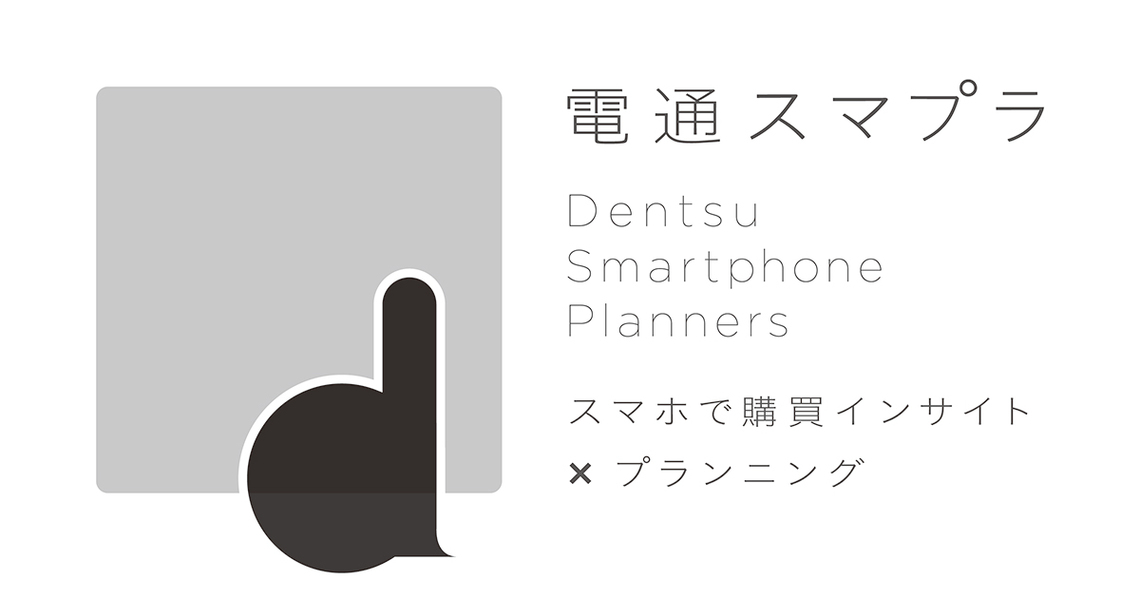
◎ What is "Dentsu Inc. Smartpla"?
It is a planning unit that contributes to launching, growing, and expanding businesses on smart devices (such as smartphones, PCs, and tablets).
Our team includes diverse professionals such as strategic planners, communication planners, consultants, copywriters, and producers, all with extensive experience in marketing communications for smartphone games and apps. Furthermore, as each member is passionate about specific areas, we support marketing activities by deeply exploring challenges and engaging clients with our unique personalities and human skills.
Was this article helpful?
Newsletter registration is here
We select and publish important news every day
For inquiries about this article
Back Numbers
Author

Yoko Seto
Dentsu Inc.
Business Transformation Division 2 Growth & HR Department
Solution Planner
Since joining the company, I have managed clients across various industries. After working in the marketing and digital departments, I now provide comprehensive support for client companies undergoing transformation. I offer consulting services for new business development, brand development, product development, and the formulation of mid-to-long-term strategies.